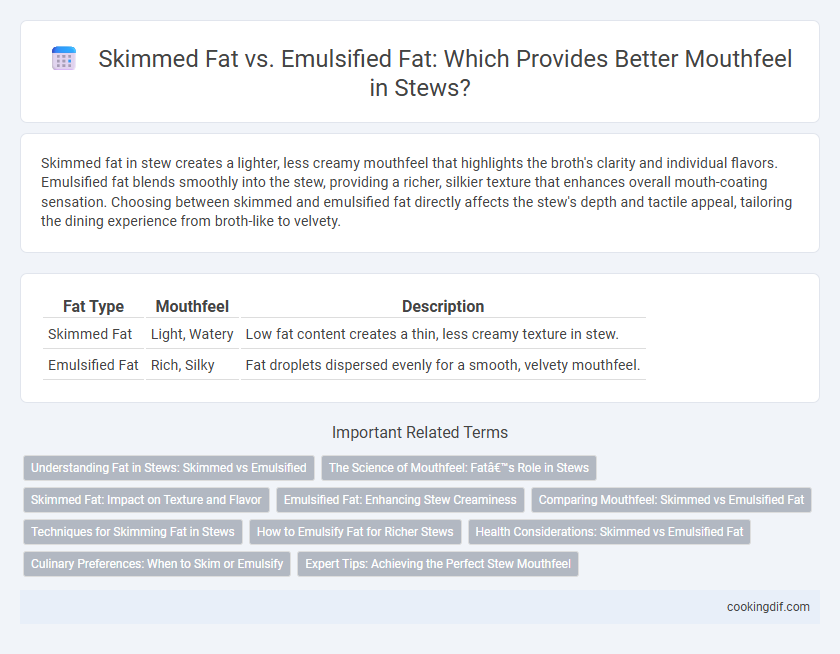Skimmed fat in stew creates a lighter, less creamy mouthfeel that highlights the broth's clarity and individual flavors. Emulsified fat blends smoothly into the stew, providing a richer, silkier texture that enhances overall mouth-coating sensation. Choosing between skimmed and emulsified fat directly affects the stew's depth and tactile appeal, tailoring the dining experience from broth-like to velvety.
Table of Comparison
| Fat Type | Mouthfeel | Description |
|---|---|---|
| Skimmed Fat | Light, Watery | Low fat content creates a thin, less creamy texture in stew. |
| Emulsified Fat | Rich, Silky | Fat droplets dispersed evenly for a smooth, velvety mouthfeel. |
Understanding Fat in Stews: Skimmed vs Emulsified
Skimmed fat in stews creates a lighter mouthfeel by removing excess oil from the surface, resulting in a cleaner taste but less richness. Emulsified fat, achieved by slow cooking and vigorous stirring, integrates fat into the liquid, producing a velvety, luxurious texture that enhances flavor depth. Understanding the balance between skimmed and emulsified fat is crucial for achieving the desired mouthfeel and flavor intensity in stew recipes.
The Science of Mouthfeel: Fat’s Role in Stews
Skimmed fat in stews reduces greasiness but often results in a thinner, less satisfying mouthfeel compared to emulsified fat, which disperses fat molecules evenly, creating a rich, velvety texture. Emulsified fat enhances the perception of creaminess and fullness by forming stable micelles that coat the palate, intensifying flavor release and mouth-coating sensations. The science of mouthfeel reveals that emulsified fats improve stew texture by balancing viscosity and lubrication, key factors that influence the overall sensory experience.
Skimmed Fat: Impact on Texture and Flavor
Skimmed fat in stew significantly reduces the richness and creamy mouthfeel compared to emulsified fat, resulting in a lighter texture that may feel less satisfying on the palate. The absence of emulsified fat's smooth dispersion causes the stew to lack the velvety consistency and integrated flavor release, often leading to a more watery and less flavorful experience. This leaner fat content enhances clarity but can sacrifice depth and roundness in both texture and taste.
Emulsified Fat: Enhancing Stew Creaminess
Emulsified fat in stew creates a smooth, velvety mouthfeel by evenly dispersing fat droplets throughout the liquid, preventing separation and enhancing creaminess. This homogeneous fat distribution improves texture and richness, making each bite more satisfying compared to the thinner, less cohesive sensation from skimmed fat. Choosing emulsified fat boosts stew quality by intensifying flavor integration and a luxurious, silky consistency.
Comparing Mouthfeel: Skimmed vs Emulsified Fat
Skimmed fat in stew offers a lighter, less creamy mouthfeel, often resulting in a thinner texture that highlights the broth's clarity. Emulsified fat creates a rich, velvety consistency, evenly distributing fat particles to enhance the stew's body and mouth-coating sensation. The choice between skimmed and emulsified fat directly influences the stew's mouthfeel, balancing between lightness and lusciousness.
Techniques for Skimming Fat in Stews
Skimming fat from stews improves mouthfeel by removing excess oil that can make the dish greasy, while emulsified fat contributes to a richer, smoother texture. Techniques for skimming fat include chilling the stew briefly to solidify fat for easy removal, using a ladle or spoon to gently lift fat off the surface, and employing specialized fat separators to strain fat from the liquid. Mastering these methods enhances the clarity and balance of the stew's flavor and texture.
How to Emulsify Fat for Richer Stews
Emulsifying fat in stews enhances mouthfeel by creating a smooth, creamy texture that skimmed fat alone cannot achieve. To emulsify fat, slowly whisk melted fat or butter into a warm, acidic liquid like stock or wine, which helps disperse fat droplets evenly throughout the stew. This technique prevents fat separation, enriches flavor, and results in a velvety consistency that intensifies the overall dining experience.
Health Considerations: Skimmed vs Emulsified Fat
Skimmed fat in stew offers a lower calorie option while maintaining a lighter mouthfeel, benefiting heart health by reducing saturated fat intake. Emulsified fat enhances texture by creating a creamy, smooth consistency that improves flavor perception but may increase saturated fat and cholesterol levels. Choosing between skimmed and emulsified fat depends on balancing desired richness with nutritional goals focused on cardiovascular health and weight management.
Culinary Preferences: When to Skim or Emulsify
Skimmed fat in stew creates a lighter mouthfeel preferred in delicate broths and lighter vegetable stews, enhancing clarity and subtle flavor profiles. Emulsified fat offers a richer, creamier texture ideal for hearty stews with meats and root vegetables, where a velvety consistency complements robust flavors. Culinary preferences dictate skimming for a clean finish or emulsifying to achieve a luxurious, full-bodied mouthfeel.
Expert Tips: Achieving the Perfect Stew Mouthfeel
Using emulsified fat in stew enhances mouthfeel by creating a silky, rich texture that coats the palate more effectively than skimmed fat. Experts recommend slowly incorporating emulsified fats like butter or rendered bacon fat to balance moisture and body, avoiding the lean, watery sensation often caused by skimmed fat. Achieving this emulsification requires gentle simmering and continual stirring to harmonize fat and broth, resulting in a luscious, satisfying stew consistency.
Skimmed fat vs emulsified fat for mouthfeel Infographic

 cookingdif.com
cookingdif.com